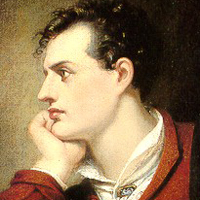She Walks in Beauty by Lord Byron: Summary and Analysis
She Walks in Beauty is an eighteen line poem written in 1814 and published in 1815. This poem is not a love poem, but a celebration of a woman's beauty. The speaker never says he is in love with the lady, but he thinks she is really beautiful.

Lord Byron (1788-1824)
The poem continues the tradition of neo-classical tradition of form in poetry. Closed form and use of iamb are its examples. In the first sestet of the poem, the speaker compares his beloved with the night of cloudless climate and starry skies. This simile brightens the combination of the best aspect of the day and light. Bright and dark color have been harmoniously combined in her eyes and aspect to make her pleasant in appearance. Highlighting her mellowed appearance, he inversely compares her with the day, which lacks that beauty. The second stanza carries on contrasting between light and dark, day and night, to describe her beauty. The third stanza concludes that she's not just beautiful, she's "good" and "innocent," too.
In this poem, the speaker is enlisting different qualities of his beloved, viz. aspect, eye, face, grace, cheek, brow, smiles, mind, thoughts and love. This technique of enlisting is known as blazon. By using blazon, he is giving a verse-compliment to his beloved. Likewise, giving a verse compliment to a lady is a cavalier tradition which the poet has borrowed from romanticism. Using the tradition, both from cavalier poetry and neo-classical poetry, he defines beauty. For Lord Byron, beauty is both inner beauty and outer beauty. Mind at peace, pure thoughts and innocent love emphasize the mental, psychological or inner beauty. Likewise, aspects like eye, face, grace, cheek and smiles represent the outer or physical beauty. For Byron, both inner and outer qualities constitute the beauty. Thus, he defines beauty in totality.
The speaker has forgotten everything in the beauty of this lady. The speaker admires the effortless harmony of a woman's beauty, and tells us that it's all about the perfect balance of light and dark in her whole face and figure. He never says he's in love with her, but the reader can guess that he's attracted to her — after all, he can't stop talking about her hair, her eyes, her cheeks. By the end of the poem, it seems like the speaker is protesting a little too much. By insisting repeatedly that the lady is pure and that her "love is innocent," it is hard not to suspect that he perhaps wishes that weren't the case.
As we observe the description of the lady we realize the inclusive definition of beauty in the poem. For Byron, beauty is both physical and spiritual. Eye, face, cheek, brow, and smiles represent the physical beauty whereas mind, heart and thought to represent the spiritual beauty.
The poem is divided into three stanzas of six lines each, with an ABABAB rhyme scheme, in iambic tetrameter with the Pyrrhic form that bring variation. The contrast between night and day, and dark and light, is the image that sets up the whole poem. If we observe the form of this poem, neo-classical tradition has been continued. It shows that the neoclassical tradition has not completely lost during romanticism. It has somehow been continued, especially by Lord Byron.
Among the cavalier poets, there was the tradition of giving a verse compliment to a lady. The cavalier poets used to forget everything seeing the beauty of their beloved. The same tradition of giving a verse compliment to a lady is continued by Lord Byron. The subject matter of this poem is borrowed from cavalier poetry and format from the neoclassical poetry. It is said that the poem is inspired by actual events in Byron’s life when he met a beautiful woman at a ball. She was his cousin by marriage. But some other critics claim that the beautiful lady might be his half-sister Augusta. Some consider this poem as the tribute to the beauty of the art.
The technique of enjambment has been used in this poem. In this technique, the first statement is presented without any punctuation marks and is followed by another line to clarify the aforementioned statement. The reinforcement of the imagery of light and dark in the poem justifies the good and bad aspects of any work of art, but still it is beautiful. Art is represented as the combination of both qualities of life. Art has contrasting parts, yet the whole art is beautiful and meaningful. In terms of the lady, she is inwardly beautiful and outwardly too, she is charming, but she may have some follies which are shadowed by her soft nature and innocent face. Byron accepts the concept of beauty as a whole that consists of both bright and dark aspects of life.
